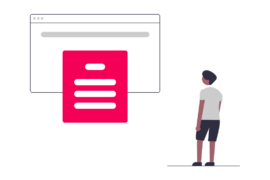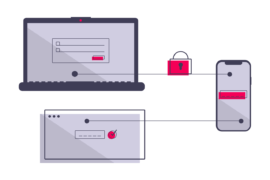Core web vitals will now form the most important metrics through which Google will assess how a publisher’s website is performing.
User experience is one of the key aspects for a website to dominate the search engine result pages. Gone are the days when publishers could rank their webpages based on keyword stuffing. With every passing Google broad core algorithm update, search results are more and more focused on satisfying user intent and experience. Therefore, publishers need to improve the overall performance of their website for ensuring a positive user experience.
Google has a variety of tools for measuring the performance of a page. But some publishers may find it daunting to use these effectively due to their technical complexity.
In order to make things slightly easier for publishers, developers, and marketers, Google has recently launched a set of performance metrics called Web Vitals.
Among different Web Vitals are Core Web Vitals, metrics that matter the most. In this blog, we are going to talk about Core Web Vitals and their importance, how publishers can improve scores for these metrics, and their future in the ad tech industry.
Core Web Vitals: Overview
After a lot of research, Google has come up with three metrics that are of high priority when it comes to measuring how users interact with a website: Loading, Interactivity, and Visual Stability
The metrics that make up Core Web Vitals are:
- Largest contentful paint (LCP)- loading
- First input delay (FID)- interactivity
- Cumulative layout shift (CLS)- visual stability
As has been already mentioned, these metrics are part of a larger concept named Web Vitals that also focus on measuring user experience.
Core Web Vitals basically quantify the very first impression that the user gets after opening a website. By using these metrics, publishers can check how users are engaging with their sites. This benefits publishers because if the user engagement is high, publishers get more opportunities to optimize their ad revenue
Let’s take a detailed look at the three Core Web Vitals.
Largest Contentful Paint
Quite simply, LCP measures the loading performance of a website. 2.5 seconds has been found to be the ideal loading speed for a website. If your website is taking more than 2.5 seconds to display the main and largest content, which can be an image or text, it means that you need to improve the LCP.
You should have fast server response time and fast resource load times for optimizing. In addition to this, client-side rendering and render-blocking JavaScript and CSS also impact LCP, which will need to be taken care of as well.
First Input Delay
This metric measures interactivity, more specifically, the time a website takes to respond after the visitor interacts (for example, clicks on a button or link) with it. A website’s FID needs to be less than 100 milliseconds for it to provide good user experience.
If you need to optimize FID for your website, decrease JavaScript execution time, improve the interaction readiness of your website, break up long tasks, and use web workers.
Cumulative Layout Shift
CLS measures how stable the elements on a website are. More specifically, this metric tells you how much elements in the viewport are shifting around as the page loads. CLS should be less than 0.1 to ensure increased page experience. The higher the CLS, the poorer the user experience will be for the website.
The major factors that can affect CLS are content that is dynamically injected, images that don’t have dimensions, actions that wait for a network response before updating DOM, embeds, ads, and iframes without dimensions, and web fonts that cause FOIT/FOUT. As a publisher, you will need to take care of these aspects for optimizing CLS.
How to Measure Core Web Vitals?
Publishers can use different tools by Google for measuring Core Web Vitals. These tools include:
- PageSpeed Insights
- Google Search Console
- Chrome UX Report
- Lighthouse
- Chrome DevTools
- Web Vitals Extension
Publishers should follow the points mentioned below for measuring Core Web Vitals.
- The very first thing you will need to do is to check the Core Web Vitals report provided by Google’s Search Console. The report will help you identify the pages for which you have to improve user experience.
- After this, you have to use PageSpeed Insights to check for lab and field issues for the identified pages.
- Once you have diagnosed all the problems with your pages, Lighthouse and Chrome DevTools will guide you through the aspects that need fixing.
- When you have fixed all the issues, the Lighthouse CI tool will allow you to check Core Web Vitals to avoid any problems before you deploy the changes.
PageSpeed Insights and Lighthouse are the two main tools that support the measurement of Core Web Vitals. Publishers can make use of other tools for further enhancing their page performance.
Why are Core Web Vitals Important?
It has become obvious by now that Google is all set to make page experience an essential component through Core Web Vitals and other Web Vital metrics. In November 2020, Google announced that page experience ranking signals will be launched in May 2021.
But why exactly is this happening and what importance do Core Web Vitals hold amidst all this?
The answer is that Core Web Vitals will be acting as a tiebreaker for websites that have quality content.
In order to understand this, publishers first need to know that page experience metrics will be a part of the ranking criteria for Google’s Top Stories feature for mobile. Currently, accelerated mobile pages (AMP) is being considered for the Top Stories feature, however, page experience will replace AMP for the same in the foreseeable future. But this does not mean that Google will stop supporting AMP.
So, user experience is about to be at the forefront with various other signals that are considered for generating search results. This being said, publishers should keep in mind that content quality still remains a key determining factor for ranking. But in cases where two pages have high quality content, page experience will become the deciding factor.
Hence, publishers now have to focus on continuously improving page experience for users and that can be done effectively by keeping track of Core Web Vitals.
What Does The Future Look Like?
While Core Web Vitals are important signals, the ad tech industry should keep an eye out for changes to the existing metrics and addition of new metrics.
Web Vitals, as a whole initiative, is bound to witness changes in the future, since the current metrics cannot be deemed perfect at this point. Publishers should be ready for such changes, as they will have significant impact when it comes to improving user engagement and revenue optimization.
What publishers can rely on is that Google will surely provide enough time for them to get acquainted with whatever changes that may occur with Core Web Vitals and other Web Vitals.
Final Thoughts
At the present time, we advise publishers to get as familiar as they can with Core Web Vitals and Web Vitals. The sooner they learn how to optimize their websites for providing the best possible user experience, the better it will be for them when the move by Google actually takes place.
The good news is that publishers can now have quantified knowledge about the performance of their pages. In addition to this, they are provided with guidance on how to fix issues that are hampering with the user experience of their pages. All this will help publishers to enhance user engagement for their website, increase traffic, and earn more revenue.
Once publishers get through the task of understanding important details about Core Web Vitals, they will see that these metrics will prove to be of great use.

Shubham is a digital marketer with rich experience working in the advertisement technology industry. He has vast experience in the programmatic industry, driving business strategy and scaling functions including but not limited to growth and marketing, Operations, process optimization, and Sales.







